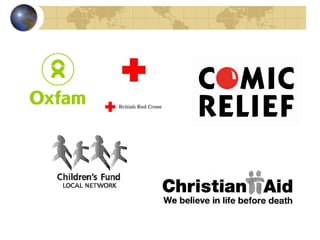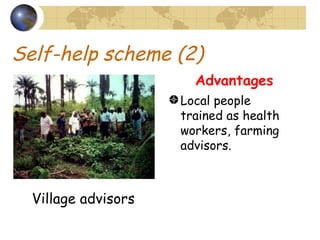International Aid
- 1. International Aid Standard Grade Geography International Issues
- 2. Introduction (1) Because LEDC pay more for their imports than they receive from their exports, they have to borrow money from banks. They then have to repay these debts, with interest, which means they have little money left to improve the standard of living of their people.
- 3. Introduction (2) They need help from other countries if they are to do this. When one country receives help from another country it is called international aid .
- 4. Types of International Aid (1) Short term aid (or emergency aid) is given when help is needed urgently. This may be because of natural disaster or because of war. In emergencies such as these, the most important help needed is food, clothing, medicine and shelter.
- 5. Types of International Aid (2) Long-term aid is given to help countries develop. It may take months or years before the aid brings any benefits. Examples of such aid include new hospitals, school, power stations, roads and irrigation schemes.
- 6. Sources of International Aid (1) Official Aid is when one country or group of countries (for example the United Nations) gives aid to another country. This money comes out of taxes.
- 7. Sources of International Aid (2) Voluntary Aid is aid given by charities. They raise money from people who make donations.
- 9. Why countries give aid (1) Aid helps trade. If aid helps developing countries to become richer, they will buy more good from developed countries. Much official aid is tied aid . This means that the country has to spend the money buying goods and services from the country that ‘gave’ it the money.
- 10. Why countries give aid (2) Giving aid means that the donor country has the support of the LEDC, which it might need at times of war. Many countries in richer, developed countries believe they should help poorer countries.
- 11. Problems with giving aid (1) Unsuitable aid
- 12. Problems with giving aid (2) Aid does not Help the most needy
- 13. Problems with giving aid (3) Aid causes other problems
- 14. Self help schemes When international aid is used for large-scale projects, such as building dams and power stations, it does not usually benefit the people who need help the most. An alternative is to use aid for self help schemes .
- 15. Self help schemes have the following characteristics: They are small scale – this makes them cheaper and means the country does not have to borrow money. They involve the local people – this means they help everyone in the area and are more likely to be successful. They use simple technology – so the skills of local people are used and they do not have to depend on experts from other countries.
- 16. International Aid Scheme (1) Needs experts from other countries to build and maintain. Large farm machinery Problems?
- 17. International Aid Scheme (2) Very expensive so few are built, and provides few jobs. Large power station Problems?
- 18. International Aid Scheme (3) Only helps people living in cities Large surgical hospitals Problems?
- 19. Self-help scheme (1) Uses local materials and is made in workshops by local people Better ploughs Advantages
- 20. Self-help scheme (2) Local people trained as health workers, farming advisors. Village advisors Advantages
- 21. Self-help scheme (3) Made cheaply in every village, providing many jobs. Bio-gas plant Advantages
- 22. Your turn Read page 106 & 107 in the text book. Answer the core questions on page 108





















